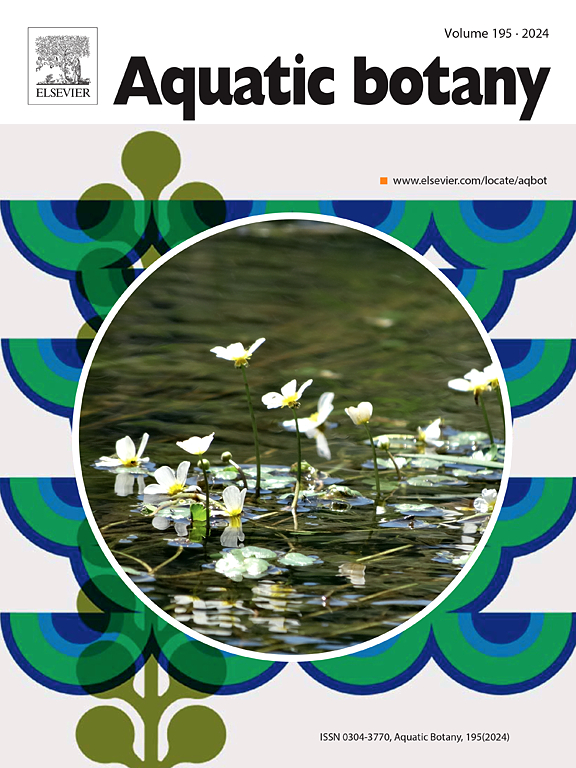温度升高对附生海草叶片生物膜NO、N2O和H2S生成及动态的影响
IF 2.6
4区 生物学
Q2 MARINE & FRESHWATER BIOLOGY
引用次数: 0
摘要
叶片附生植物有可能减少海草夜间的氧气供应,导致微生物产生温室气体和植物毒素,这可能对植物有害。然而,目前尚不清楚全球变暖如何影响黑暗期间海草层的反硝化和硫酸盐还原等厌氧过程。利用电化学微传感器测量了14°C和24°C条件下重度附生海草叶片微环境中O2、NO、N2O和H2S的梯度随温度的变化规律。海水温度的升高刺激了缺氧海草叶层内的植物毒性H2S的产生和积累,这对植物是有害的,因为H2S容易通过海草叶片的薄角质层扩散。海草叶层也在黑暗中产生了强大的温室气体N2O,并通过基叶分生组织向植株扩散NO。因此,温度升高和水柱中氧气可用性降低,例如,在富营养化水域的海洋热浪期间,可以在海草层圈中诱发不利的化学条件,这可能对植物的性能和生态功能有害。与H2S相比,层际圈NO和N2O的动态对海水温度升高的响应有限,但附生植物覆盖的海草叶片中N2O的产生及其向周围海水的排放可能对海草草甸在温室气体减缓中的作用产生影响。本文章由计算机程序翻译,如有差异,请以英文原文为准。
Effects of increasing temperature on NO, N2O and H2S production and dynamics within epiphytic seagrass leaf biofilms
Leaf epiphytes have potential to reduce seagrasses nighttime O2 supply leading to microbial production of greenhouse gases and phytotoxins that may be harmful to the plant. However, it remains unknown how global warming affects anaerobic processes like denitrification and sulfate reduction in the seagrass phyllopshere during darkness. We used electrochemical microsensors to measure gradients of O2, NO, N2O and H2S in the leaf microenvironment of heavily epiphyte-covered seagrass (Zostera marina L.) during darkness as a function of temperature at 14 and 24 °C. Increasing seawater temperature stimulated phytotoxic H2S production and accumulation within anoxic seagrass phyllospheres in darkness, which can be harmful to the plant as H2S readily diffuses through the thin cuticle of seagrass leaves. The seagrass phyllosphere also exhibited production of NO, which was diffusing into the plant as measured in the basal leaf meristem, as well as the potent greenhouse gas N2O during darkness. Increased temperature and reduced O2 availability in the water-column, e.g., during marine heatwaves in eutrofied waters, can thus induce hostile chemical conditions in the seagrass phyllosphere that potentially can be detrimental for the plant’s performance and ecological function. The phyllosphere dynamics of NO and N2O displayed limited response to increasing seawater temperatures as compared to H2S, but the N2O production in epiphyte-covered seagrass leaves and subsequent emission to the surrounding seawater could have implications for the role of seagrass meadows in greenhouse gas mitigation.
求助全文
通过发布文献求助,成功后即可免费获取论文全文。
去求助
来源期刊

Aquatic Botany
生物-海洋与淡水生物学
CiteScore
3.80
自引率
5.60%
发文量
70
审稿时长
6 months
期刊介绍:
Aquatic Botany offers a platform for papers relevant to a broad international readership on fundamental and applied aspects of marine and freshwater macroscopic plants in a context of ecology or environmental biology. This includes molecular, biochemical and physiological aspects of macroscopic aquatic plants as well as the classification, structure, function, dynamics and ecological interactions in plant-dominated aquatic communities and ecosystems. It is an outlet for papers dealing with research on the consequences of disturbance and stressors (e.g. environmental fluctuations and climate change, pollution, grazing and pathogens), use and management of aquatic plants (plant production and decomposition, commercial harvest, plant control) and the conservation of aquatic plant communities (breeding, transplantation and restoration). Specialized publications on certain rare taxa or papers on aquatic macroscopic plants from under-represented regions in the world can also find their place, subject to editor evaluation. Studies on fungi or microalgae will remain outside the scope of Aquatic Botany.
 求助内容:
求助内容: 应助结果提醒方式:
应助结果提醒方式:


